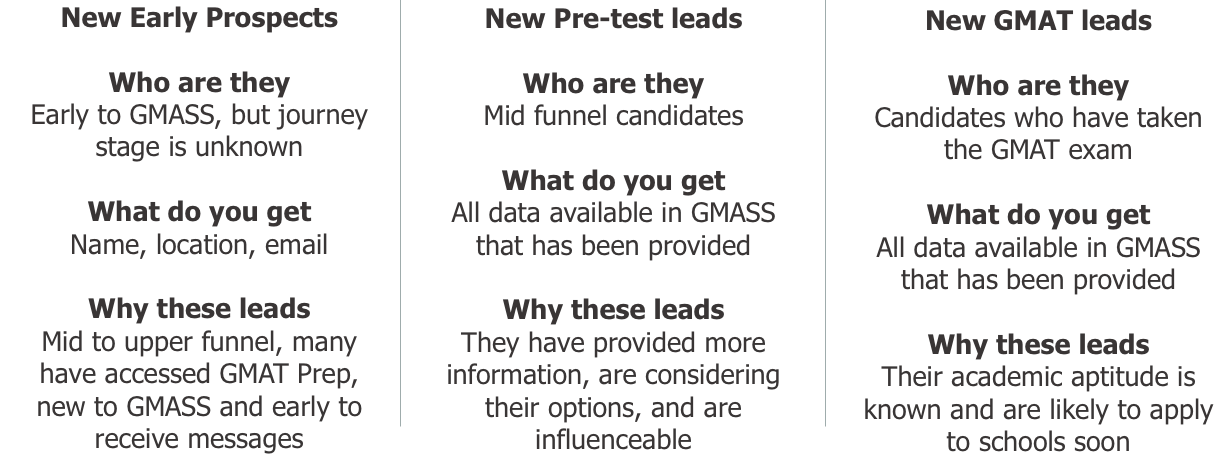
It’s another busy recruiting season with demand for graduate management education on the rise. And, with face-to-face meetings still a challenge, online communications are as important as ever.
In this context, how can you reach, engage, and recruit the right candidates for your business school? How can you create convincing messages that stand out against your competition?
In our latest GMAC Connect Presents webinar—Are your messages breaking through the noise this recruiting season?—we shared the best strategies for success using GMASS.
1. Understand your audience
The first thing to do before marketing your MBA and business master’s programs is to understand the candidate audience that you’re speaking to.
The GMASS search service gives you access to a 600,000-strong database of business school candidates who have indicated that they’re serious about graduate school. In the past 12 months, almost 200,000 new candidates have opted into GMASS.
Those candidates are divided into three kinds of profiles:

Early Prospects are fresh candidates who likely haven’t heard from your competitors and who you can get in front of with your brand and unique value proposition first.
Pre-Test candidates are mostly still considering their options, so you have a good chance of conversion especially if you can align what your program has to offer with their career goals.
GMAT leads are ready to apply and have demonstrated their academic readiness for your program.
GMASS candidates provide information about their career ambitions, preferred program type, and study location.
While 57% of new GMASS candidates express an interest in full-time programs, over 30% of the GMASS database has not stated a preference for full-time or part-time—a significant area of opportunity.
2. Tap into candidate trends
Data from the Graduate Management Admission Council (GMAC) can also help you tap into candidate trends and adapt your marketing messages accordingly.
We’re seeing an increase in younger candidates (under 24 years old). More women are interested in programs with a flexible, online component than men. There’s significant growth in candidates who have yet to decide on their preferred program type.
GMAC’s Prospective Students Survey also reveals the top career goals of candidates and how they vary across program types.
 Source: mba.com Prospective Students Survey. GMAC.com/research. Data collected between Jan-Jun, 2021
Source: mba.com Prospective Students Survey. GMAC.com/research. Data collected between Jan-Jun, 2021
These goals vary by citizenship too. Candidates from most regions select salary increase as one of their top options. However, candidates in Nigeria are most interested in obtaining executive positions while Indian candidates are especially motivated by the prospect of working internationally.
Consulting, technology, and finance remain the most popular industry destinations. International MBA candidates prefer tech to finance, possibly due to higher expectations of employability and visa potential.
3. Tailor your messaging
Once you know your audience, you need to tailor your marketing strategy and messaging to match their profiles.
For early prospects candidates, try setting up an 8-to-10 email drip campaign where the first half of your emails are focused on the benefits of pursuing a graduate business degree. Send an email every 14 days and if a candidate takes an action, move them to another nurture campaign that is more targeted. If they get through the whole nurture without taking any action, send the same email series, but with different subject lines.
For pre-Test leads, reach out to those candidates who are still undecided in their program choices and career goals. This is an influenceable group and reaching out to them is a good way to get your message across before a competitor does. Also, check whether they have a GMAT exam date in the GMASS download file—you want to be sure they’re thinking of your program when they go to take the test.
For GMAT leads, make sure there is more urgency in your subject lines—these candidates are likely to apply in the next 1-3 months. Use all the data available to you to target these candidates by email, but also by text, call, and on social media.
Think also about the wider context candidates are applying in. COVID-19 and visas are significant areas of concern for international candidates while messaging around ROI and career outcomes remain popular.
You should also use GMASS to target candidates based on their study preferences and career goals. If you’re recruiting for a Master in Finance, for example, make sure you target candidates whose current and desired industries are finance.
4. Optimize your marketing emails
To help optimize your marketing emails, tap into the expertise of the GMAC Client Success team.
Based on current email trends from Worldata, open rates increased by…
- 34% for emails with listicle-style subject lines. For example: ‘5 Reasons To Get An MBA.’
- 31% for emails with subject lines around exclusivity. Use this language with the GMAT test takers and to promote webinars and info sessions.
- 29% for subject lines focused on what’s coming up in candidates’ areas of interest. For example: ‘What is the future of finance?’
- 24% for subject lines with three dots (…) at the end.
Remember: make sure the website page you send candidates to from your email contains a clear call-to-action (CTA) and its design matches the template of your email. You might create the most compelling marketing email but if your CTA takes them to a confusing page, you’re likely to lose a possible lead.
5. Learn from your colleagues
In our latest GMAC Connect Presents webinar, James Kent, Marketing Manager at China Europe International Business School (CEIBS), explained how he shifted his approach to using GMASS to boost recruitment (webinar recording).
CEIBS previously used GMASS to make project-based purchases, purchasing international leads with little targeting. With support from the GMASS team, CEIBS pivoted to purchasing new leads on a monthly basis with international leads based on a target student profile.
By focusing on key data points—including preferred region of study, citizenship, work experience, age, and language—CEIBS was able to create a series of emails targeting candidates at various stages of their application journey with subjects ranging from ‘Get to know the CEIBS MBA in five videos’ to ‘Book your 1-on-1 consultation with CEIBS MBA admissions’.
Cameron Collins, Senior Marketing Manager at Vanderbilt University, Owen Graduate School of Management, explained how setting up recurring searches to pull new lists of candidates from GMASS every two weeks helped triple the number of submitted applications to the school (webinar recording).
He set up 18 different automated searches across various criteria, segmenting candidates by their location, GMAT scores, career goals, and stage in the application journey to nurture them in different ways.
Cameron also recommends centralizing purchasing of GMASS leads within your school, rather than having different programs or departments purchasing different leads. This cohesive strategy helped reduce Owen’s cost per submitted application. To nurture candidate leads in the most effective way, you should also integrate GMASS data fields within your school’s own CRM system.
“We’ve seen a lot of success with GMASS, especially with pre-test candidates,” said Cameron. “GMASS is our largest source of attributable leads and our most cost-effective way of generating leads.”
